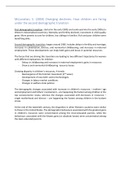McLanahan, S. (2004) Diverging destinies: How children are faring
under the second demographic transition
First demographic transition: started in the early 1800s and continued into the early 1900s (in
Western industrialised countries). Mortality and fertility declined, investment in child quality
grew. More parents to care for children, less siblings in families. Rich and poor children were
benefiting alike.
Second demographic transition: began around 1960. Includes delays in fertility and marriage;
increases in cohabitation, divorce, and nonmarital childbearing; and increases in maternal
employment. These developments can imply both gains and losses in parental resources.
The forces that are driving this transition are leading to two different trajectories for women
with different implications for children:
- Delays in childbearing and increases in maternal employment: gains in resources
- Divorce and nonmarital childbearing: resource losses
Growing disparity in children’s resources, 4 trends:
- Reemergence of the feminist movement (2nd wave)
- Development of new birth control technologies
- Changes in labour market conditions
- Changes in welfare-state policies
The demographic changes associated with increases in children’s resources – mothers’ age
and employment and fathers’ involvement – are happening the fastest among children in the
top socioeconomic strata, whereas the changes associated with decreases in resources –
single motherhood and divorce – are happening the fastest among children in the bottom
strata.
At the end of the twentieth century, the disparities in other Western countries were similar
to those in the United States. The demographic behaviours associated with the greatest gains
in children's resources were concentrated among the most-educated parents, while the
behaviours associated with the fewest gains (or absolute losses) were concentrated among
the least-educated parents.
,Sweeney, M.M. (2002) Two decades of family change: The shifting
economic foundations of marriage
Men and women are growing to resemble each other with respect to the relationship
between economic prospects and marriage (even though this is primarily due to changing
patterns of marriage among women – not so much due to men).
Economic independence hypothesis: women with good prospects in the labour market are
less likely to marry than women with relatively poorer prospects.
Career-entry theory of marriage: developed by Oppenheimer. Suggests that changing
conditions in the labour market have fundamentally altered the nature of the marital bargain.
A certain standard of living must be obtained before marriage is considered affordable.
Specialisation and trading model of marriage: developed by Becker. Views single men and
women as trading partners who choose to marry only when both partners believe that they
will be better off married than single.
Theory of marriage timing: developed by Oppenheimer. Argues that the economic
underpinnings of marriage are shifting, because women are increasingly expected to keep on
working throughout their lives and men are less and less able to independently support their
families.
Absolute earnings: the amount of money you make / relative earnings: the money you make
relative to your spouse.
Conclusion of the article: continued growth in women’s position in the labour market should
not further reduce the likelihood of marriage among young people. Instead, improvements in
the earnings of both women and men can be expected to increase the likelihood of marriage.
, Kalmijn, M. (2013) The educational gradient in marriage: A comparison
of 25 European countries
Gradient: sort of movement or stream into a certain direction (either upwards or
downwards).
Entry versus exit: entry stands for “ever married” versus “never married”, exit stands for
“divorced” versus “married”.
Better-educated people usually marry later than others because of extended schooling and
the tendency not to marry while in school. In the United States, it appears that better-
educated men and women are now more likely to marry than less-educated men and women.
Previous research has suggested that a new marriage gradient has emerged in the United
States, with marriage becoming increasingly the privilege of the better-educated. However,
this is not yet clear for Europe, which is why this article focuses on the European countries.
In countries where gender roles are traditional, better-educated women are less likely to be
married than less-educated women; in gender-egalitarian countries, better-educated women
are more likely to be married. For men, the educational effect on marriage is absent in
traditional countries but becomes positive as gender roles become more equal (in other
words: in gender-egalitarian countries, better-educated men are more likely to be married,
just like women). Inequality in a society also modifies the gradient: if the degree of economic
inequality between educational groups in a society is strong, better-educated men are more
likely to be married than less-educated men.
The results for women were consistent with theoretical expectations. The hypothesis was: in
traditional countries, there is negative educational effect on marriage for women. In these
countries, better-educated women are less dependent on marriage for financial security,
have poorer changes on the marriage market because their economic characteristics in
marriage are relatively unimportant, and have limited desire to be married because having
both a career and a family cannot be combined very well. In more gender-egalitarian
countries, the independence argument becomes less relevant, and the marriage market
chances of better-educated women improve because men begin to attach more weight to
women’s economic potential.
The results for men, there were different hypotheses. The economic hypothesis was: as
gender roles become more egalitarian, the effects of men’s education would become weaker.
In gender-egalitarian countries, married women work more often, and men contribute more
to domestic labour and child-raising, which means that men’s economic characteristics are
expected to be less important. This hypothesis is not supported by the data when education
is used as a measure of economic status. The effect of men’s education becomes stronger
rather than weaker as gender roles become more egalitarian.
Differences in the educational gradient are linked to the degree of educational inequality in a
society. The positive effect of men’s education on marriage is stronger in societies where




